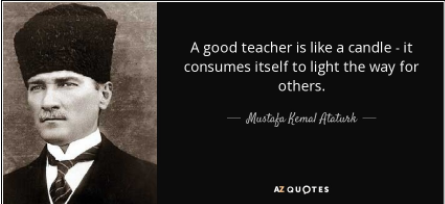Have you found yourself tired lately, teacher? Yes, need-a-nap tired, but also tired in your muscles and your bones and your mind?
You’ve been working hard, sure. Long days on your feet, lots of time staring at a screen, but it’s more than that.
You’ve been making innumerable decisions every minute of every day, and you’ve been thinking often about your students (maybe a few in particular) and your classroom, and you’ve been working with skill and soul to mold minds and hearts. Of course, you’re exhausted.
An Unquotable Quote
If you’ve spent any amount of time on social media, it’s more than likely that you’ve seen this meme (or a razzle-dazzled version) making the rounds. “A good teacher is like a candle — it consumes itself to light the way for others.” – Mustafa Kemal Ataturk

Image credit: https://www.azquotes.com/quote/530784
While it likely comes from a place of appreciation, it is misguided. So…
Thanks, but no thanks, Mr. Ataturk.
I am not a candle.
I am not a consumable resource.
Let’s examine why this quote makes me defensive. The glaring issue with his statement is the underlying assumption that teachers don’t need or deserve boundaries. Right now, the word “boundaries” is suffering from what my friend, Dave Stuart, Jr., calls “buzzwordification.” It’s a word that keeps getting thrown around to mean a lot of different things until we all think we know what it means and we’re sick of hearing about it. But every time it’s thrown into a conversation that isn’t wrapped in context, its meaning is diluted, and therefore its power is extinguished.
I have found through reading, research, and personal work (I’ve done with the help of my counselor) that there are four critical and complementary elements to boundaries that interlock to form something like a safety net: personal responsibility, sacred space, communication, and practical limits. These may be best explained through an extended metaphor, so close your eyes and picture your home, sweet home.

The Four Elements of Boundaries
1) Find the Line
Where is the property line on your little patch of heaven? First, this is the limit of your property in the world. Within these lines, you need to tend your lawn, you need to take out your trash, you need to water your flowers. Your property is your responsibility only, not anybody else’s. This is the first component of boundaries: the limit of what one individual is responsible for in the world. What are the things required of you?
Already, some of you are feeling overwhelmed in thinking about all you “have” to do, but this is crucial: everyone else is responsible for themselves, too. Unless someone is your child, you are not responsible for feeding that person or clothing them or taking them to the doctor.
That is not to say we can’t choose to help them, but we acknowledge that this is a choice. This thing we are doing is not our personal responsibility, and so we are extending beyond what we have to do. Even if we do this 29 times, we are still not obligated to do it a 30th. More on this in a minute.
Think about your personal responsibility as a teacher. We have committed to teach curriculum, to take care of the children we are entrusted with, to keep them safe and give them opportunities to learn. Teachers often feel they are responsible for continuing every. single. thing. they’ve done to support a student. We do an awful lot of fancy-pants stuff beyond what we must … which is okay. It’s important to distinguish between what we are truly responsible for and the tasks we choose to bear.
2) Cultivate Your Space
Now imagine the way it feels to be at home. Envision the privileges you enjoy as a property owner. You have a right to decide whether someone else is invited into your home (if someone uninvited enters, we call that trespassing, and it’s a crime). You get to choose whether to plant begonias or roses or nothing at all. This component of boundaries is the concept of safe, sacred space.
In our bodies, we call this “personal space” or a “personal bubble.” But we are also entitled to “personal space” of the mind. You get to decide what, or who, you expend mental energy on. You are entitled to your own thoughts and opinions and desires, and you’re empowered to seek healthy conditions.
Do you love the quiet? That’s your safe space, and you get to ask for it. Do you love being around close friends? That’s your sacred space, and you get to ask for it.
Think about your sacred personal space as a teacher. We can probably all think of a time when a situation or individual consumed our every spare thought, both during the school day and beyond. This likely raised your stress level, as I know it did mine. This was the result of an invasion of your sacred space; a boundary transgressed. Your body responded with the cortisol levels of a threatening invader. However, we cannot expect others to respect our choices unless we communicate our wants and needs clearly.
3) Communicate Your Boundaries
The adage, “Tall fences make for great neighbors” helps us understand the third element of boundaries. When my neighbor and I have absolute clarity on what I need to take care of (my lawn, my begonias) and what I can count on them to take care of, we are less likely to have a misunderstanding that could lead to conflict.
In life, we don’t walk around wearing white picket fences, nor should we. Our boundary communication has to be done almost entirely with our language. We have to tell people what we are able to give, willing to do, and need in return.
But somewhere along the way, we were taught that it’s impolite or inappropriate to be direct in expressing what we need. We sometimes “chicken out” of being clear about our fences, which leads to confusion about where the boundary actually lies. This is a recipe for tension and conflict. Instead, be clear about what you will and will not do. It is more than okay to save some time in the day for yourself.
4) Reign Yourself In
I don’t know anybody who mows all the yards on their street. I know lots of people who mow their own yards, who live next to people who also mow their own yards. Lots of these people even live in neighborhoods without fences! How do they do this? They know the boundary of their property line and they’ve established guidelines that tell them how far they have to mow and when to turn the tractor around.
We need realistic guidelines that remind us when it’s time to turn the tractor around. Here are some practical limits I have set for myself:
- I don’t check my school email in the evenings. Period.
- I don’t work during my lunch break.
- When I’m feeling overwhelmed by work, I eliminate new tasks rather than working longer hours.
- I give myself a bedtime and I stick to it.
These are the guidelines I established for myself, knowing what I wanted to cultivate in my space. In practice, your limits will likely be different, because you likely have different desires and priorities.
Know what your responsibilities are so you can also know what they are not.
Establish a safe space so that you can communicate how to keep it safe.
Decide what you need in your space in order to know what to keep out.
Implementing just one of these four elements is unlikely to yield the kind of transformation that many of us need in order to make teaching more sustainable.
Alright, back to Mr. Ataturk’s attempt at teacher appreciation.
Get Back Inside Your Boundaries
So must we allow ourselves to, as Mr. Ataturk suggests, be consumed to light the way for others? Sure, it sounds noble to sacrifice our own needs to meet the needs of everyone else, but what happens when we burn out? Are we watering our neighbor’s lawn while our own house is on fire?
Often as teachers, we dissolve our boundaries for very nice reasons. We feel called to help everybody, all the time. We think we have to save every child, and that giving anything less than 100% all the time is selfish. Though we might think we are capable of doing all these things, we simply are not. We must define, communicate, and defend our boundaries to find balance.
While it is possible to be an effective teacher without balance, you cannot be effective for very long. It’s just not sustainable. In the absence of intentional balance, the balance will decide itself. For example:
- I do not have enough time to do all I need to do, so I will give up time for sleep.
- I do not have enough energy to do all I need to do, so I will give up something fun.
- I do not have enough emotional bandwidth to live wholeheartedly, so I will give up joy.
We must adopt some humility and acknowledge that we cannot keep doing what we’ve been doing. It’s killing us and it’s stealing our joy. We might have to admit that we’re just humans, and not supernatural beings after all.
Flip the Script
So first things first: clarify your own boundaries. What are you responsible for? What do you need to let go of? What are your needs? How are you letting other people know these things? Where are you mowing more lawn than you have to?
Consciously reject the message that being a good teacher is synonymous with being overworked and unsustainable. Say to yourself, “Having balance in my life makes me a better teacher.”

When you feel twinges of guilt because you’re not checking your email as much, tell yourself, “Having balance in my life makes me a better teacher.”
When someone is upset with you for no longer solving their problems, remind yourself, “Having balance in my life makes me a better teacher.”
When you fall asleep on the couch at 4 pm and don’t finish your grading or your housework, say it out loud, “Having balance in my life makes me a better teacher. And, naps don’t hurt either.”

Taylor Funk
Middle School Math & Science Teacher
Discussion
Leave a Reply
OR

Join our
community
of educators
If you are a teacher who is interested in contributing to the Truth for Teachers website, please click here for more information.
















Thanks! Great points, especially in this teaching era of higher and higher expectations for communication.
Continuing Ed
You are remarkable! Continue your inspiring articles and help for teachers everywhere dear girl!!!
This is an excellent, relevant read! Thank you for your contribution.
So helpful, I’ve read it twice to remind myself of all the useful tips. Thank you